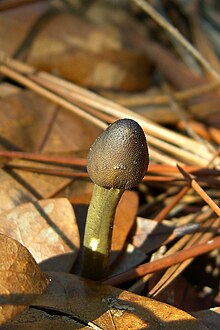Hypocreales
| Hypocreales | |
|---|---|

| |
| Scientific classification | |
| Kingdom: | Fungi |
| Division: | Ascomycota |
| (unranked): | Sordariomyceta |
| Class: | Sordariomycetes |
| Subclass: | Hypocreomycetidae |
| Order: | Hypocreales Lindau (1897) |
| Families | |
|
Bionectriaceae | |
The Hypocreales are an order of fungi within the class Sordariomycetes. In 2008, it was estimated that it contained some 237 genera, and 2647 species in seven families.[1] Since then, a considerable number of further taxa have been identified, including an additional family, the Stachybotryaceae.[2] According to the Catalog of Life, As of April 2021 the Hypocreales contains 6 families, 137 genera, and 1411 species.[3]
Species of Hypocreales are usually recognized by their brightly colored, perithecial ascomata, or spore-producing structures. These are often yellow, orange or red.
Genera incertae sedis[]
According to a 2020 review of fungal classification, the following genera within the Hypocreales have an uncertain taxonomic placement (incertae sedis), and have not been assigned to any family:[4]
- A.Giraldo, Gené & Guarro (2014) – 1 sp.
- Berkelella (Sacc.) Sacc. (1891) – 2 spp.
- Bulbithecium Udagawa & T.Muroi (1990) – 1 sp.
- Peyronel (1916) – 10 spp.
- Etayo, Flakus & Kukwa (2017) – 1 sp.
- Etayo (2017) – 1 sp.
- Grove (1916) – ca. 7 spp.
- †Entropezites[5] Poinar & R.Buckley 2007) – 1 sp.
- Döbbeler (2012) – 1 sp.
- Hapsidospora Malloch & Cain (1970) – 2 spp.
- G.L.Barron (1991) – 3 spp.
- D.Hawksw. (2001) – 1 sp.
- Mart. (1817) – 17 spp.
- Etayo (2017) – 2 spp.
- Metadothella Henn. (1904) – 1 sp.
- Speg. (1886) – 4 spp.
- †Mycetophagites[5] Poinar & R.Buckley (2007) – 1 sp.
- Petr. (1847) – 1 sp.
- Peloronectria Möller (1901) – 3 spp.
- Crous (2014) – 1 sp.
- Pseudomeliola Speg. (1889) – 10 spp.
- Doveri, Pecchia, Sarrocco & Vannacci (2016) – 1 sp.
- Vain (1921) – 19 spp.
- A.N.Rai & P.N.Singh (2018) – 1 sp.
- K.L.Pang, Alias & E.B.G.Jones (2010) – 1 sp.
- W.Gams, O'Donnell, Schroers & M.Chr. (1999) – 4 spp.
- Lindau (1900) – 61 spp.
- Ticonectria Döbbeler (1998) – 3 spp.
- Tilakidium Vaidya, C.D.Naik & Rathod (1986) – 1 sp.
References[]
- ^ Kirk PM, Cannon PF, Minter DW, Stalpers JA (2008). Dictionary of the Fungi (10th ed.). Wallingford, UK: CAB International. p. 332. ISBN 978-0-85199-826-8.
- ^ Lombard, L; Houbraken, J; Decock, C; Samson, RA; Meijer, M; Réblová, M; Groenewald, JZ; Crous, PW (2016). "Generic hyper-diversity in Stachybotriaceae". Persoonia. 36: 156–246. doi:10.3767/003158516X691582. PMC 4988370. PMID 27616791.
- ^ Source dataset. Species Fungorum Plus: Species Fungorum for CoL+. "Sordariales". Catalog of Life. Retrieved 27 April 2021.
- ^ Wijayawardene, Nalin; Hyde, Kevin; Al-Ani, Laith Khalil Tawfeeq; Somayeh, Dolatabadi; Stadler, Marc; Haelewaters, Danny; et al. (2020). "Outline of Fungi and fungus-like taxa". Mycosphere. 11: 1060–1456. doi:10.5943/mycosphere/11/1/8.
- ^ Jump up to: a b Poinar GO, Buckley R (2007). "Evidence of mycoparasitism and hypermycoparasitism in Early Cretaceous amber". Mycological Research. 111 (4): 503–506. doi:10.1016/j.mycres.2007.02.004. PMID 17512712.
External links[]
 Media related to Hypocreales at Wikimedia Commons
Media related to Hypocreales at Wikimedia Commons
- Hypocreales
- Ascomycota orders
- Taxa described in 1897